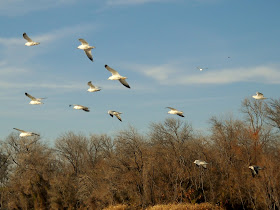Did you know that White Rock Lake in Dallas, Texas was once
an ancient sea?
North America was literally divided into two landmasses by a
large inland sea called the Western Interior Seaway (also called the Cretaceous
Seaway and the North American Inland Sea) that existed during the Mid-to-Late
Cretaceous Period.
Western Interior Seaway - 100 million years ago
This ancient, shallow sea had abundant marine life and stretched
from the Gulf of Mexico in the south and through the middle of what we now know
as the United States and Canada, meeting with the Arctic Ocean to the north. This
sea was 600 miles wide and over 2,000 miles long. All of Texas would have been
covered by this ancient sea.
The Cretaceous period succeeded the Jurassic Period approximately
144 million years ago and lasted to approximately 65 million years ago. The
word Cretaceous comes from the word for "chalk," a
soft, white, porous sedimentary rock that is a form of limestone. Indeed, if
you walk around White Rock Lake, you will see intermittent outcrops of white
limestone, and this is how the lake got its name: White Rock Lake.
If you look carefully at these limestone
outcrops, you may be lucky enough to identify crustacean shells dating back to
the Cretaceous Period, such as these found at Winfrey Point.
Shells and other items found in the limestone at Winfrey Point
The sea began to wane about 70 million years ago and the
ancient sea bed gradually became exposed over time through erosion and other
upheavals. This ancient sea bed is the white rock that we now see exposed
around the lake, especially the area below the spillway where large tracts of
limestone are clearly visible, and known locally as Austin stone.
It is during the Cretaceous Period that we find the first
fossils of many insect groups, modern mammal and bird groups, and the first
flowering plants (called angiosperms). Around White Rock Lake, the most common
fossils to be found are organisms such as clams and oysters. Shark teeth, fish
and marine reptile remains have also been found at the lake on rare occasions.
A closer view of the shells
At the end of the Cretaceous Period, 65 million years ago,
an asteroid hit Earth in the Yucatan Peninsula, Mexico. This event resulted is
what we now call the Chicxulub impact crater, buried under the Yucatan
Peninsula. The crater is more than 110 miles in diameter.
It has been estimated that half of the world's species went
extinct at about this time (including the Dinasaurs), either from the impact of
the asteroid or other reasons, such as environmental changes. Whatever the cause of this extinction, this asteroid
event marks the end of the Cretaceous Period.
The next time you take a walk around White Rock Lake, keep
your eyes peeled. That stone you are kicking may just turn out to be a 60
million-year-old fossil.


















